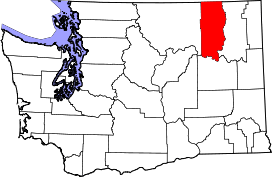Danville, Washington
| Danville, Washington | |
|---|---|
| Census-designated place | |
 Danville  Danville | |
| Coordinates: 48°59′33″N 118°30′29″W / 48.99250°N 118.50806°WCoordinates: 48°59′33″N 118°30′29″W / 48.99250°N 118.50806°W | |
| Country | United States |
| State | Washington |
| County | Ferry |
| Area | |
| • Total | 0.18 sq mi (0.46 km2) |
| • Land | 0.18 sq mi (0.46 km2) |
| • Water | 0.0 sq mi (0.0 km2) |
| Elevation | 1,745 ft (532 m) |
| Population (2010) | |
| • Total | 34 |
| • Density | 191/sq mi (73.8/km2) |
| Time zone | Pacific (PST) (UTC-8) |
| • Summer (DST) | PDT (UTC-7) |
| ZIP code | 99121 |
| Area code(s) | 509 |
| GNIS feature ID | 1518480[1] |
| FIPS code | 53-16585 |
Danville is an unincorporated community and census-designated place (CDP) in Ferry County, Washington, United States. Danville is located on Washington State Route 21 near the Canada–United States border, 31 miles (50 km) north-northeast of Republic, the Ferry County seat. Danville has a post office with ZIP code 99121.[2] The population at the 2010 census was 34.[3]
History
Danville was founded in 1899 and took its name from the Danville Mining Company.[4]
Danville was the first town in the county. It was originally known as "Nelson" and was established in 1889 by the Nelson brothers. By 1897 the town had half a dozen businesses and a post office. The town also had the first newspaper in the county, called the Reservation Record. In 1897 the Nelson brothers built a commodious store right on the international boundary, with a north entrance and a south entrance. The north entrance was to serve the Canadian patrons, and the south entrance was for the American patrons. The authorities suspected customs duty evasion and closed the store. In 1901 the Great Northern Railway built through Nelson. The railroad officials had Nelson's name changed to "Danville" to avoid confusion with Nelson in British Columbia. When the mines in the area became depleted, Danville slipped in importance.[5]
1920s
In the 1920s some level of prosperity returned to Danville with Prohibition. Danville became a whiskey smugglers' rendezvous. The whiskey smugglers used local guides and old trails to avoid detection by the border authorities. When Prohibition came to an end, Danville went into a state of decline. The town changed as a series of fires also took their toll. It was rumored that Old Man Jennings, the justice of the peace, used to counterfeit half dollars.[5]
Lost gold ledge
A prospector named John Falconer was working in Danville during the summer of 1912. At that time an electrical storm passed through the area and ignited a tree on a hillside to the southeast of town. Falconer proceeded on horse along a game trail toward the distant fire in order to put it out. Along the way it began to rain and his horse's hoof trod on a rock in the middle of the trail. y the time Falconer reached the fire the rain had put it out. As Falconer made his way home he stumbled upon the rock he initially found. He took the rock home and figured it was full of "pyrites".[5] A few months later Falconer realized the rock was full of gold and not pyrite. The gold slab was worth over $1,000.00 and weighed 50 troy ounces of gold at $20.67 an ounce.[5] Old timers in Danville have called the slab "the golden plate".[5] It is believed the gold slab was part of a gold ledge. Falconer and his wife searched for the original location where the rock came from but were unable to find it. Many have searched for Danville's gold ledge in the hills southeast of the city. It is believed more gold waits to be discovered where the gold slab was found. No one has found the gold ledge.[5]
References
- ↑ U.S. Geological Survey Geographic Names Information System: Danville, Washington
- ↑ ZIP Code Lookup
- ↑ "Geographic Identifiers: 2010 Demographic Profile Data (G001): Danville CDP, Washington". U.S. Census Bureau, American Factfinder. Retrieved October 21, 2016.
- ↑ Majors, Harry M. (1975). Exploring Washington. Van Winkle Publishing Co. p. 55. ISBN 978-0-918664-00-6.
- 1 2 3 4 5 6 N.L. Barlee, Gold Creeks and Ghost Towns of Northeastern Washington, Hancock House Publishers, 2004
